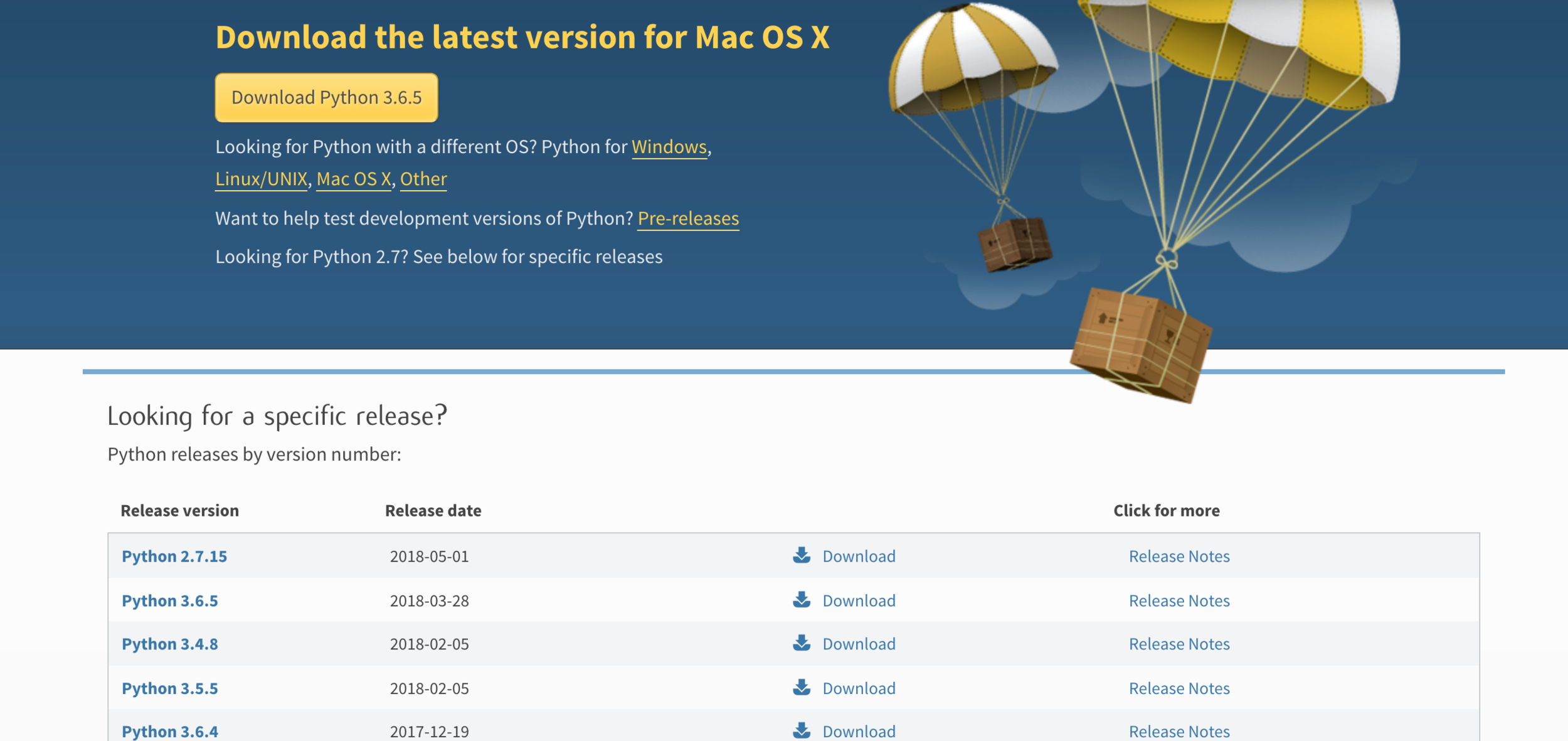Python
~ Crash Course ~
UNIFEI - June, 2018
Hello!
Prof. Maurilio
Hanneli
Prof. Bonatto



Moodle
<3
Questions
- What is this course?
- A: An attempt to bring interesting subjects to the courses
- Why are the slides in English?
- I am reusing some material that I prepared before
- What should I expect?
- This is the first time we give this course. We will be looking forward to hearing your feedback
Rules and Notes
- Don't skip classes
- The final assignment is optional
- Feel free to ask questions
- We plan to record the classes and upload the videos
DISCLAIMER
This is NOT a Python tutorial
[GIF time]

Goals
- First contact with Python
- Tools for science and Engineering
- How to ask proper questions to Google
- (try to) Use all the code that is already done
- Some recipes for transforming a problem into an automated task
Agenda
- Why Python?
- Getting Started (installation, important tools)
- Hello, Python! (super basic, boring and necessary intro)
- Our first problem: Getting online data
- Data and Numpy
- More interesting libraries
(Note: This list can change!)
Agenda
- Why Python?
- Getting Started (installation, important tools)
- Hello, Python! (super basic, boring and necessary intro)
- Our first problem: Getting online data
- Data and Numpy
- More interesting libraries
(Note: This list can change!)

The benefits of Python

The benefits of Python
- Easy to learn
- Lots of libraries
- Lots of libraries for science and engineering
- Good performance
- Good for Web Development
- Good for automating tasks
Agenda
- Why Python?
- Getting Started (installation, important tools)
- Hello, Python! (super basic, boring and necessary intro)
- Our first problem: Getting online data
- Data and Numpy
- More interesting libraries
Linux, MacOS
Python is already there :)
Windows
https://www.python.org/downloads/windows/

Python 3 or Python 2?
Python 3, please
We don't really need to install Python to use it
Let's try it out!
There is a good place for writing and testing your Python code
Jupyter Notebooks
Jupyter Notebooks
- Easy to see the results
- Easy to test
- Good for documenting your research
- Easy to share
You can use it online or in your computer
How can we get all the cool libraries written in Python?

It is time for the black screen os h4ck3rs
You need to use your terminal (Linux, MacOS) or the Windows Prompt
pip
Once you install pip, you can have all the cool libraries in your machine
Ex: Jupyter Notebooks
pip install jupyterjupyter notebookQuestion:
Which libraries can I download?

In practice
Tips:
- Look for Open Source tools
- Check the source and see if the library is stable and has frequent updates
Agenda
- Why Python?
- Getting Started (installation, important tools)
- Hello, Python! (super basic, boring and necessary intro)
- Our first problem: Getting online data
- Data and Numpy
- More interesting libraries
We often need to collect online data (for research, personal projects, etc)
Scraping my wishlists at Amazon


What do we do now?
scrapy (install it with pip)
pip install scrapyGoal
1. Obtain the book title and price of all the items of the wishlist
2. Save all this information in a local file
Goal
1. Obtain the book title and price of all the items of the wishlist
2. Save all this information in a local file
Everything that you see in a webpage is...
Text

It is all a bunch of text with markups to indicate style, position of the elements,...
This is what we call HTML

image from amazon.com.br
We must dig into this text and find the information we want
The idea of the algorithm

For every book, get the title and price; move to the next book; stop when you reach the end of the wishlist
image from amazon.com.br
Can the library (scrapy) do that?
Smart move
scrapy shell 'https://www.amazon.com.br/gp/registry/wishlist/3DA4I0ZLH8ADW'response.text
How do I reproduce this action into a Jupyter Notebook or Python file?
Use the command 'scrapy shell' was unfair
import scrapy
class ShortParser(scrapy.Spider):
name = 'shortamazonspider'
start_urls =
['https://www.amazon.com.br/gp/registry/wishlist/3DA4I0ZLH8ADW']
def parse(self, response):
print(response.text)short_parser.py
C:\> scrapy runspider short_parser.pyC:\> scrapy runspider short_parser.py > page.txtimport scrapy
from scrapy.crawler import CrawlerProcess
class ShortParser(scrapy.Spider):
name = 'shortamazonspider'
start_urls =
['https://www.amazon.com.br/gp/registry/wishlist/3DA4I0ZLH8ADW']
def parse(self, response):
print(response.text)
process = CrawlerProcess({
'USER_AGENT': 'Mozilla/4.0 (compatible; MSIE 7.0; Windows NT 5.1)'
})
process.crawl(ShortParser)
process.start()
the script will block here until the crawling is finishedshort_parser.py
C:\> python short_parser.py
TOO MANY THINGS GOING ON!!!111
Goal
1. Obtain the book title and price of all the items of the wishlist
2. Save all this information in a local file
Questions:
- What is 'class'?
- How did you know about that method parse?
- I have a big chunk of code. Now what? How do I extract the information I need?
Wrap Up
- Python basics
- Installation
- Using the tools and the language
- Extra: Where to learn more (Coursera)
import scrapy
class ShortParser(scrapy.Spider):
name = 'shortamazonspider'
start_urls =
['https://www.amazon.com.br/gp/registry/wishlist/3DA4I0ZLH8ADW']
def parse(self, response):
print(response.text)short_parser.py
Read the Docs! https://doc.scrapy.org/


The Docs will help you using the library. They usually have examples
Going back to our problem
1. Obtain the book title and price of all the items of the wishlist
2. Save all this information in a local file
We still need to clean up the information inside the HTML and collect only a few information about the books
Since HTML has "markups", we can fetch the information we want
(whiteboard time - how does HTML represent the content?)

All the books are inside this element 'div#item-page-wrapper'
import scrapy
class ShortParser(scrapy.Spider):
name = 'shortamazonspider'
start_urls =
['https://www.amazon.com.br/gp/registry/wishlist/3DA4I0ZLH8ADW']
def parse(self, response):
books_root = response.css("#item-page-wrapper")amazon_spider.py
Note: Python relies on indentation.
import scrapy
class ShortParser(scrapy.Spider):
name = 'shortamazonspider'
start_urls =
['https://www.amazon.com.br/gp/registry/wishlist/3DA4I0ZLH8ADW']
def parse(self, response):
books_root = response.css("#item-page-wrapper")amazon_spider.py
What is the output of this method call?
Scrapy shell is useful here!
scrapy shell 'https://www.amazon.com.br/gp/registry/wishlist/3DA4I0ZLH8ADW'In [4]: books_root = response.css("#item-page-wrapper")
In [5]: books_root
Out[5]: [<Selector xpath="descendant-or-self::*[@id = 'item-page-wrapper']"
data='<div id="item-page-wrapper" class="a-sec'>]
Let's see the examples again. We have something called 'Selector'
In [4]: books_root = response.css("#item-page-wrapper")
In [5]: books_root
Out[5]: [<Selector xpath="descendant-or-self::*[@id = 'item-page-wrapper']"
data='<div id="item-page-wrapper" class="a-sec'>]


Out[5]: [<Selector xpath="descendant-or-self::*[@id = 'item-page-wrapper']"
data='<div id="item-page-wrapper" class="a-sec'>]
The information of every book is inside the 'div#itemMain_[WeirdCode]'
How can we select
'div#itemMain_[WeirdCode]' ?
We know this information always starts with itemMain_, followed by anything
We can use a Regular Expression - we tell to the algorithm: 'Select the items that are called #itemMain[I_dont_care]'
import scrapy
class ShortParser(scrapy.Spider):
name = 'shortamazonspider'
start_urls =
['https://www.amazon.com.br/gp/registry/wishlist/3DA4I0ZLH8ADW']
def parse(self, response):
books_root = response.css("#item-page-wrapper")
books = books_root.xpath('//div[re:test(@id, "itemMain_*")]')amazon_spider.py
What is the output of this method call?
Back to Scrapy shell!
scrapy shell 'https://www.amazon.com.br/gp/registry/wishlist/3DA4I0ZLH8ADW'In [4]: books_root = response.css("#item-page-wrapper")
In [5]: books_root
Out[5]: [<Selector xpath="descendant-or-self::*[@id = 'item-page-wrapper']"
data='<div id="item-page-wrapper" class="a-sec'>]In [6]: books = books_root.xpath('//div[re:test(@id, "itemMain_*")]')
In [7]: books
Out[7]:
[<Selector xpath='//div[re:test(@id, "itemMain_*")]' data='<div id="itemMain_I2Y87PJXIXDI9X" class='>,
<Selector xpath='//div[re:test(@id, "itemMain_*")]' data='<div id="itemMain_I1B5CM41FDBQQU" class='>,
<Selector xpath='//div[re:test(@id, "itemMain_*")]' data='<div id="itemMain_I3JPI776YSPWGL" class='>,
<Selector xpath='//div[re:test(@id, "itemMain_*")]' data='<div id="itemMain_I2HEQ767OEDQND" class='>,
<Selector xpath='//div[re:test(@id, "itemMain_*")]' data='<div id="itemMain_I12P3TV8OT8VUQ" class='>,
<Selector xpath='//div[re:test(@id, "itemMain_*")]' data='<div id="itemMain_I2PUS0RW7H14QK" class='>,
<Selector xpath='//div[re:test(@id, "itemMain_*")]' data='<div id="itemMain_I2Z1XDSQWY482G" class='>,
<Selector xpath='//div[re:test(@id, "itemMain_*")]' data='<div id="itemMain_I1UIZOCDVDCJCN" class='>,
<Selector xpath='//div[re:test(@id, "itemMain_*")]' data='<div id="itemMain_IVVEST5SABEDL" class="'>,
<Selector xpath='//div[re:test(@id, "itemMain_*")]' data='<div id="itemMain_IO58MH5C88JMF" class="'>]Those are the books! Now we can obtain the title and the price
import scrapy
class ShortParser(scrapy.Spider):
name = 'shortamazonspider'
start_urls =
['https://www.amazon.com.br/gp/registry/wishlist/3DA4I0ZLH8ADW']
def parse(self, response):
books_root = response.css("#item-page-wrapper")
books = books_root.xpath('//div[re:test(@id, "itemMain_*")]')amazon_spider.py
import scrapy
class ShortParser(scrapy.Spider):
name = 'shortamazonspider'
start_urls =
['https://www.amazon.com.br/gp/registry/wishlist/3DA4I0ZLH8ADW']
def parse(self, response):
books_root = response.css("#item-page-wrapper")
books = books_root.xpath('//div[re:test(@id, "itemMain_*")]')
for book in books:amazon_spider.py
import scrapy
class ShortParser(scrapy.Spider):
name = 'shortamazonspider'
start_urls =
['https://www.amazon.com.br/gp/registry/wishlist/3DA4I0ZLH8ADW']
def parse(self, response):
books_root = response.css("#item-page-wrapper")
books = books_root.xpath('//div[re:test(@id, "itemMain_*")]')
for book in books:
book_info = book.xpath('.//div[re:test(@id, "itemInfo_*")]')
title = book_info.xpath('.//a[re:test(@id, "itemName_*")]/text()')
.extract_first()amazon_spider.py
Now we have the values of title and price, for every iteration
We want these results only when the code runs
yield
import scrapy
class ShortParser(scrapy.Spider):
name = 'shortamazonspider'
start_urls = ['https://www.amazon.com.br/gp/registry/wishlist/3DA4I0ZLH8ADW']
def parse(self, response):
books_root = response.css("#item-page-wrapper")
books = books_root.xpath('//div[re:test(@id, "itemMain_*")]')
for book in books:
book_info = book.xpath('.//div[re:test(@id, "itemInfo_*")]')
title = book_info.xpath('.//a[re:test(@id, "itemName_*")]/text()').extract_first()
price = book_info.xpath('.//span[re:test(@id, "itemPrice_*")]//span/text()').extract_first()
yield {'Title':title, 'Last price':price }amazon_spider.py
Going back to our problem
1. Obtain the book title and price of all the items of the wishlist
2. Save all this information in a local file

Problem: this code only considers the first books. There are many books. How can we fetch info from all the books?
(This is an optional homework!)
Note about scraping data: Digging into the HTML structure can be tricky
There may be many ways to extract the data and the code can get obsolete with any minor changes on the webpage
Agenda
- Why Python?
- Getting Started (installation, important tools)
- Hello, Python! (super basic, boring and necessary intro)
- Our first problem: Getting online data
- Data and Numpy
- More interesting libraries
New problem: We don't need to scrape the data. It comes from a .csv file
For example, the students of this course
From the form, I obtained a python_ext.csv file
julianafandrade@hotmail.com,Juliana Figueiredo de Andrade,34293,ECO
jianthomaz1994@gmail.com,Jian Thomaz De Souza ,2018013906,ECO
ranierefr@hotmail.com,Frederico Ranieri Rosa,2017020601,ECO
pievetp@gmail.com,Dilson Gabriel Pieve,2017006335,ECO
henrqueolvera@gmail.com,Henrique Castro Oliveira,2018003703,CCO
fabio.eco15@gmail.com,Fábio Rocha da Silva,31171,ECO
ftdneves@gmail.com,Frederico Tavares Direne Neves,2016014744,ECO
gabrielocarvalho@hotmail.com,Gabriel Oraboni Carvalho,33549,CCO
laizapaulino1@gmail.com,Laiza Aparecida Paulino da Silva,2016001209,SIN
rodrigogoncalvesroque@gmail.com,Rodrigo Gonçalves Roque,2017004822,CCO
jlucasberlinck@hotmail.com,João Lucas Berlinck Campos ,2016017450,ECO
sglauber26@gmail.com,Glauber Gomes de Souza,2016014127,CCO
ricardoweasley@hotmail.com,Ricardo Dalarme de Oliveira Filho,2018002475,CCO
caikepiza@live.com,Caike De Souza Piza,2016005404,ECO
henriquempossatto@gmail.com,Henrique Marcelino Possatto ,2017007539,ECO
souza.isa96@gmail.com,Isabela de Souza Silva,2017000654,SIN
felipetoshiohikita@gmail.com,FELIPE TOSHIO HIKITA DA SILVA,34948,ECOWe want to get this information into Python and analyse it
LMGTFY
'Load CSV file to Python'
Pandas Library
Install it with pip
pip install pandas
Recipe
- Add the python_ext.csv file to a directory
- Create a file students.py at the same directory
import pandas as pd
df = pd.read_csv('python_ext.csv')
print(df)3. On the terminal, run `python students.py`

Now we can manipulate this data
Send emails
Generate QRCodes
Statistics
df.groupby('curso').count()['matricula']Tip: Obtaining data

Agenda
- Why Python?
- Getting Started (installation, important tools)
- Hello, Python! (super basic, boring and necessary intro)
- Our first problem: Getting online data
- Data and Numpy
- More interesting libraries
Wrap Up
A complete Scraper
Pandas and Datasets
Exercises


Moodle
<3
Working with Arrays
LMGTFY
'library arrays in Python'
NumPy Library
Install it with pip
pip install numpyTry these examples from DataCamp
(note: you can skip the first part where they suggest installing Anaconda)

Extra - challenge from Kaggle (Jun 11th - Jun 17th)
Feedback
Thank you :)
Questions?
hannelitaa@gmail.com
@hannelita
